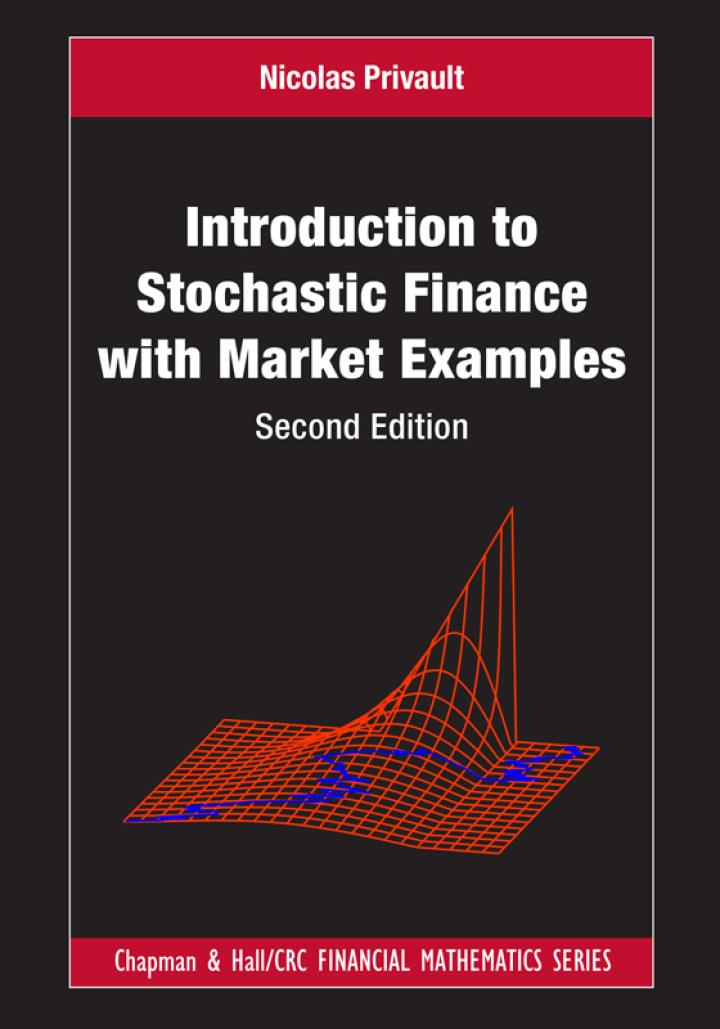Consider an underlying asset whose price is written as [S_{t}=S_{0} mathrm{e}^{r t+sigma B_{t}-sigma^{2} t / 2}, quad
Question:
Consider an underlying asset whose price is written as
\[S_{t}=S_{0} \mathrm{e}^{r t+\sigma B_{t}-\sigma^{2} t / 2}, \quad t \geqslant 0\]
where \(\left(B_{t}\right)_{t \in \mathbb{R}_{+}}\)is a standard Brownian motion under the risk-neutral probability measure \(\mathbb{P}^{*}, \sigma>0\) denotes the volatility coefficient, and \(r \in \mathbb{R}\) is the risk-free interest rate. For any \(\lambda \in \mathbb{R}\) we consider the process \(\left(Z_{t}^{(\lambda)}\right)_{t \in \mathbb{R}_{+}}\)defined by \[\begin{align*}
Z_{t}^{(\lambda)} & :=\mathrm{e}^{-r t}\left(S_{t}\right)^{\lambda} \\
& =\left(S_{0}\right)^{\lambda} \mathrm{e}^{\lambda \sigma B_{t}-\lambda^{2} \sigma^{2} t / 2+(\lambda-1)\left(\lambda+2 r / \sigma^{2}\right) \sigma^{2} t / 2}, \quad t \geqslant 0 \tag{15.38}
\end{align*}\]
a) Assume that \(r \geqslant-\sigma^{2} / 2\). Show that, under \(\mathbb{P}^{*}\), the process \(\left(Z_{t}^{(\lambda)}\right)_{t \in \mathbb{R}_{+}}\)is a supermartingale when \(-2 r / \sigma^{2} \leqslant \lambda \leqslant 1\), and that it is a submartingale when \(\lambda \in\) \(\left(-\infty,-2 r / \sigma^{2}\right] \cup[1, \infty)\).
b) Assume that \(r \leqslant-\sigma^{2} / 2\). Show that, under \(\mathbb{P}^{*}\), the process \(\left(Z_{t}^{(\lambda)}\right)_{t \in \mathbb{R}_{+}}\)is a supermartingale when \(1 \leqslant \lambda \leqslant-2 r / \sigma^{2}\), and that it is a submartingale when \(\lambda \in\) \((-\infty, 1] \cup\left[-2 r / \sigma^{2}, \infty\right)\).
c) From this question onwards, we assume that \(r<0\). Given \(L>0\), let \(\tau_{L}\) denote the hitting time \[\tau_{L}=\inf \left\{u \in \mathbb{R}_{+}: S_{u}=L\right\}\] d) Deduce an upper bound on the price \[\mathbb{E}^{*}\left[\mathrm{e}^{-r \tau_{L}}\left(K-S_{\tau_{L}}\right)^{+} \mid S_{0}=x\right]\] e) Show that when \(r \leqslant-\sigma^{2} / 2\), the upper bound of Question (d) increases and tends to \(+\infty\) when \(L\) decreases to 0 . f) Find an upper bound on the price \[\mathbb{E}^{*}\left[\mathrm{e}^{-r \tau_{L}}\left(S_{\tau_{L}}-K\right)^{+} \mathbb{1}_{\left\{\tau_{L}<\infty\right\}} \mid S_{0}=x\right]\] (f) increases in \(L \geqslant K\), and tends to \(S_{0}\) as \(L\) increases to \(+\infty\).
By application of the Stopping Time Theorem 14.7 to \(\left(Z_{t}^{(\lambda)}\right)_{t \in \mathbb{R}_{+}}\)to suitable values of \(\lambda\), show that \[\mathbb{E}^{*}\left[\mathrm{e}^{-r \tau_{L}} \mathbb{1}_{\left\{\tau_{L}<\infty\right\}} \mid S_{0}=x\right] \leqslant \begin{cases}\left(\frac{x}{L}\right)^{\operatorname{Max}\left(1,-2 r / \sigma^{2}\right)}, & x \geqslant L \\ \left(\frac{x}{L}\right)^{\min \left(1,-2 r / \sigma^{2}\right)}, & 0
of the American put option exercised in finite time under the stopping strategy \(\tau_{L}\) when \(L \in(0, K)\) and \(x \geqslant L\).
of the American call option exercised in finite time under the stopping strategy \(\tau_{L}\) when \(L \geqslant K\) and \(x \leqslant L\).
g) Show that when \(-\sigma^{2} / 2 \leqslant r<0\), the upper bound of Question
Step by Step Answer:

Introduction To Stochastic Finance With Market Examples
ISBN: 9781032288277
2nd Edition
Authors: Nicolas Privault





